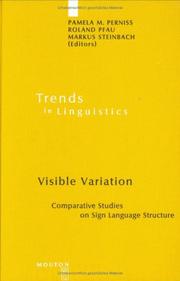| Listing 1 - 2 of 2 |
Sort by
|
Book
ISBN: 1563686570 9781563686573 1563686562 9781563686566 Year: 2015 Volume: 21 Publisher: Washington, D.C. Gallaudet Univ Press
Abstract | Keywords | Export | Availability | Bookmark
 Loading...
Loading...Choose an application
- Reference Manager
- EndNote
- RefWorks (Direct export to RefWorks)
International Sign (IS) is widely used among deaf people and interpreters at international events, but what exactly is it, what are its linguistic features, where does its lexicon come from, and how is it used at interpreted events? This groundbreaking collection is the first volume to provide answers to these questions. Editors Rachel Rosenstock and Jemina Napier have assembled an international group of renowned linguists and interpreters to examine various aspects of International Sign. Their contributions are divided into three parts: International Sign as a Linguistic System; International Sign in Action--Interpreting, Translation, and Teaching; and International Sign Policy and Language Planning. The chapters cover a range of topics, including the morphosyntactic and discursive structures of interpreted IS, the interplay between conventional linguistic elements and nonconventional gestural elements in IS discourse, how deaf signers who use different signed languages establish communication, Deaf/hearing IS interpreting teams and how they sign depicting verbs, how best to teach foundation-level IS skills, strategies used by IS interpreters when interpreting from IS into English, and explorations of the best ways to prepare interpreters for international events. The work of the editors and contributors in this volume makes International Sign the most comprehensive, research-based analysis of a young but growing field in linguistics and interpretation.
Sign language. --- Linguistics. --- Linguistic science --- Science of language --- Language and languages --- Deaf --- Gesture language --- Gesture --- Signs and symbols --- Sign language --- #KVHA:Taalkunde; Gebarentaal


ISBN: 9783110198850 3110198851 9783110195781 311019578X 1282194593 9781282194595 9786612194597 6612194596 Year: 2008 Volume: 188 Publisher: Berlin Boston
Abstract | Keywords | Export | Availability | Bookmark
 Loading...
Loading...Choose an application
- Reference Manager
- EndNote
- RefWorks (Direct export to RefWorks)
It has been argued that properties of the visual-gestural modality impose a homogenizing effect on sign languages, leading to less structural variation in sign language structure as compared to spoken language structure. However, until recently, research on sign languages was limited to a number of (Western) sign languages. Before we can truly answer the question of whether modality effects do indeed cause less structural variation, it is necessary to investigate the similarities and differences that exist between sign languages in more detail and, especially, to include in this investigation less studied sign languages. The current research climate is testimony to a surge of interest in the study of a geographically more diverse range of sign languages. The volume reflects that climate and brings together work by scholars engaging in comparative sign linguistics research. The 11 articles discuss data from many different signed and spoken languages and cover a wide range of topics from different areas of grammar including phonology (word pictures), morphology (pronouns, negation, and auxiliaries), syntax (word order, interrogative clauses, auxiliaries, negation, and referential shift) and pragmatics (modal meaning and referential shift). In addition to this, the contributions address psycholinguistic issues, aspects of language change, and issues concerning data collection in sign languages, thereby providing methodological guidelines for further research. Although some papers use a specific theoretical framework for analyzing the data, the volume clearly focuses on empirical and descriptive aspects of sign language variation.
Sign language. --- Language and languages --- Psycholinguistics. --- Linguistic change. --- Langage par signes --- Variation (Linguistique) --- Psycholinguistique --- Changement linguistique --- Variation. --- linguistic typology. --- Linguistic change --- Psycholinguistics --- Sign language --- Variation
| Listing 1 - 2 of 2 |
Sort by
|

 Search
Search Feedback
Feedback About UniCat
About UniCat  Help
Help News
News